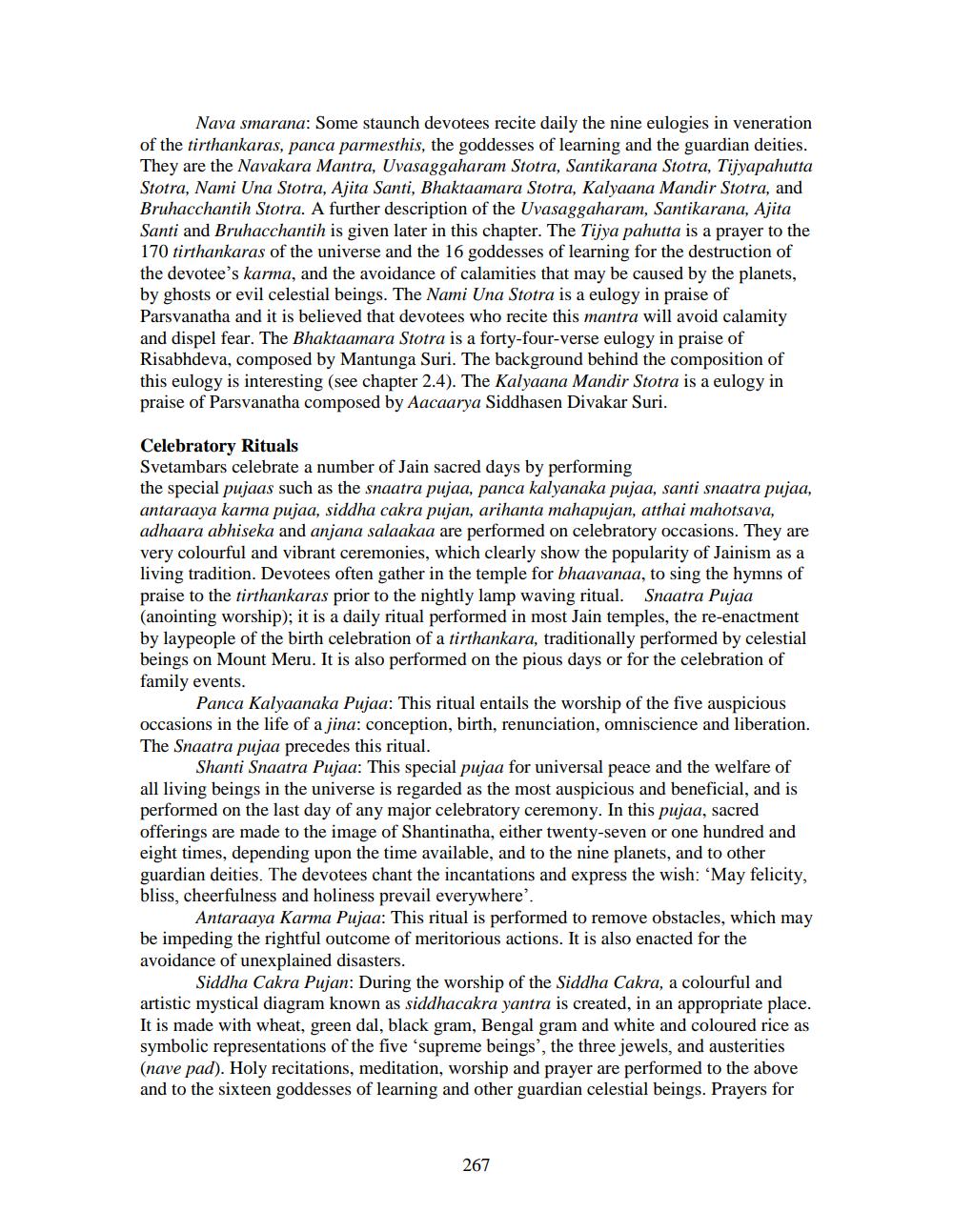________________
Nava smarana: Some staunch devotees recite daily the nine eulogies in veneration of the tirthankaras, panca parmesthis, the goddesses of learning and the guardian deities. They are the Navakara Mantra, Uvasaggaharam Stotra, Santikarana Stotra, Tijyapahutta Stotra, Nami Una Stotra, Ajita Santi, Bhaktaamara Stotra, Kalyaana Mandir Stotra, and Bruhacchantih Stotra. A further description of the Uvasaggaharam, Santikarana, Ajita Santi and Bruhacchantih is given later in this chapter. The Tijya pahutta is a prayer to the 170 tirthankaras of the universe and the 16 goddesses of learning for the destruction of the devotee's karma, and the avoidance of calamities that may be caused by the planets, by ghosts or evil celestial beings. The Nami Una Stotra is a eulogy in praise of Parsvanatha and it is believed that devotees who recite this mantra will avoid calamity and dispel fear. The Bhaktaamara Stotra is a forty-four-verse eulogy in praise of Risabhdeva, composed by Mantunga Suri. The background behind the composition of this eulogy is interesting (see chapter 2.4). The Kalyaana Mandir Stotra is a eulogy in praise of Parsvanatha composed by Aacaarya Siddhasen Divakar Suri.
Celebratory Rituals Svetambars celebrate a number of Jain sacred days by performing the special pujaas such as the snaatra pujaa, panca kalyanaka pujaa, santi snaatra pujaa, antaraaya karma pujaa, siddha cakra pujan, arihanta mahapujan, atthai mahotsava, adhaara abhiseka and anjana salaakaa are performed on celebratory occasions. They are very colourful and vibrant ceremonies, which clearly show the popularity of Jainism as a living tradition. Devotees often gather in the temple for bhaavanaa, to sing the hymns of praise to the tirthankaras prior to the nightly lamp waving ritual. Snaatra Pujaa (anointing worship); it is a daily ritual performed in most Jain temples, the re-enactment by laypeople of the birth celebration of a tirthankara, traditionally performed by celestial beings on Mount Meru. It is also performed on the pious days or for the celebration of family events.
Panca Kalyaanaka Pujaa: This ritual entails the worship of the five auspicious occasions in the life of a jina: conception, birth, renunciation, omniscience and liberation. The Snaatra pujaa precedes this ritual.
Shanti Snaatra Pujaa: This special pujaa for universal peace and the welfare of all living beings in the universe is regarded as the most auspicious and beneficial, and is performed on the last day of any major celebratory ceremony. In this pujaa, sacred offerings are made to the image of Shantinatha, either twenty-seven or one hundred and eight times, depending upon the time available, and to the nine planets, and to other guardian deities. The devotees chant the incantations and express the wish: 'May felicity, bliss, cheerfulness and holiness prevail everywhere
Antaraaya Karma Pujaa: This ritual is performed to remove obstacles, which may be impeding the rightful outcome of meritorious actions. It is also enacted for the avoidance of unexplained disasters.
Siddha Cakra Pujan: During the worship of the Siddha Cakra, a colourful and artistic mystical diagram known as siddhacakra yantra is created, in an appropriate place. It is made with wheat, green dal, black gram, Bengal gram and white and coloured rice as symbolic representations of the five 'supreme beings', the three jewels, and austerities (nave pad). Holy recitations, meditation, worship and prayer are performed to the above and to the sixteen goddesses of learning and other guardian celestial beings. Prayers for
267




